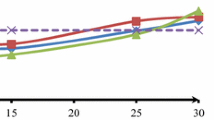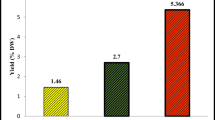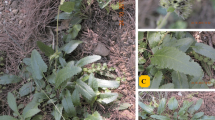Abstract
This study is designed to examine the chemical composition and in vitro antioxidant activity of the hydrodistillated essential oil and the various extracts of alkanet (Alkanna tinctoria subsp. tinctoria). Gas chromatography (GC) and GC-mass spectrometry (GC-MS) analysis of the essential oil were resulted in the determination of 27 different compounds, representing 93.32% of the total oil. The major compounds detected in the oil, were pulegone (22.27%), 1,8-cineole (13.03%), α-terpinyl acetate (6.87%), and isophytol (6.83%), respectively. Antioxidant activities of the samples were determined by 4 different test systems namely β-carotene/linoleic acid, 1,1-diphenyl-2-picrylhydrazyl (DPPH), reducing power, and chelating effect. In all systems, essential oil showed the weakest activity profile. On the other hand, ethyl acetate and water extracts exhibited excellent antioxidant activities. As well as the antioxidant activities of the extracts, they were evaluated in terms of their total phenolic and flavonoid contents. In parallel to the experiments, ethyl acetate and water extracts were found to be rich-in these phytochemicals.
Similar content being viewed by others
References
Halliwell B, Gutteridge JMC. Free Radicals in Biology and Medicine. 3rd ed. Oxford University Press, New York, NY, USA. pp. 1–35 (1999)
Mantle D, Eddeb F, Pickering AT. Comparison of relative antioxidant activities of British medicinal plant species in vitro. J. Ethnopharmacol. 72: 47–51 (2000)
Di Carlo G, Mascolo N, Izzo AA, Capasso F. Flavonoids old and new aspects of a class of natural therapeutic drugs. Life Sci. 65: 337–353 (1999)
Pulido R, Bravo L, Saura-Calixto F. Antioxidant activity of dietary polyphenols as determined by a modified ferric reducing/antioxidant power assay. J. Agr. Food Chem. 48: 3396–3402 (2000)
Sumino M, Sekine T, Ruangrungsi N, Igarashi K, Ikegami F. Ardisiphenols and other antioxidant principles from the fruits of Ardisia colorata. Chem. Pharm. Bull. 50: 1484–1487 (2002)
Kinsella JE, Frankel E, German B, Kanner J. Possible mechanisms for the protective role of antioxidants in wine and plant foods. Food Technol.-Chicago 47: 85–89 (1993)
Terao J, Piskula MK. Flavonoids as inhibitors of lipid peroxidation in membranes. pp. 277–295. In: Flavonoids in Health and Disease. aRice-Evans CA, Packer L (eds). Marcel Dekker, New York, NY, USA (1997)
Duthie GG. Lipid peroxidation. Eur. J. Clin. Nutr. 47: 759–764 (1993)
Valentao P, Fernandes E, Carvalho F, Andrade PB, Seabra RM, Bastos M. Antioxidative properties of cardoon (Cynara cardunculus L.) infusion against superoxide radical, hydroxyl radical, and hypochlorous acid. J. Agr. Food Chem. 50: 4989–4993 (2002)
Adams RP. Identication of Essential Oil Components by Gas Chromatography/Mass Spectrometry. 4th ed. Allured Publishing Corp., Carol Stream, IL, USA (2007)
Dapkevicius A, Venskutonis R, Van Beek TA, Linssen PH. Antioxidant activity of extracts obtained by different isolation procedures from some aromatic herbs grown in Lithuania. J. Sci. Food Agr. 77: 140–146 (1998)
Hatano T, Kagawa H, Yasuhara T, Okuda T. Two new flavonoids and other constituents in licorice root: Their relative astringency and radical scavenging effects. Chem. Pharm. Bull. 36: 1090–1097 (1988)
Oyaizu M. Studies on products of browning reactions: Antioxidative activities of browning reaction prepared from glucosamine. Jpn. J. Nutr. 44: 307–315 (1986)
Dinis TCP, Madeira VMC, Almeida LM. Action of phenolic derivates (acetoaminophen, salycilate, and 5-aminosalycilate) as inhibitors of membrane lipid peroxidation and as peroxyl radical scavengers. Arch. Biochem. Biophys. 315: 161–169 (1994)
Slinkard K, Singleton VL. Total phenol analyses: Automation and comparison with manual methods. Am. J. Enol. Viticult. 28: 49–55 (1977)
Arvouet-Grand A, Vennat B, Pourrat A, Legret P. Standardisation d’un extrait de propolis et identification des principaux constituants (Standardization of propolis extract and identification of componts). J. Pharm. Belg. 49: 462–468 (1994)
Tzakou O, Loukis A. Chemical composition of Alkanna orientalis L. from Greece. J. Essent. Oil Res. 20: 490–491 (2008)
Hayouni A, Abedrabba M, Bouix M, Hamdi M. The effects of solvents and extraction method on the phenolic contents and biological activities in vitro of Tunisian Quercus coccifera L. and Juniperus phoenicea L. fruit extracts. Food Chem. 105: 1126–1134 (2007)
Kamath V, Rajini PS. The effcacy of cashew nut (Anacardium occidentale L.) skin extract as a free radical scavenger. Food Chem. 103: 428–433 (2007)
Frankel EN, Meyer AS. The problems of using one-dimensional methods to evaluate multifunctional food and biological antioxidants. J. Sci. Food Agr. 80: 1925–1941 (2000)
Siddhuraju P. Antioxidant activity of polyphenolic compounds extracted from defatted raw and dry heated Tamarindus indica seed coat. Lebensm.-Wiss. Technol. 40: 982–990 (2007)
Thaipong K, Boonprakob U, Crosby K, Cisneros-Zevallos L, Bryne DH. Comparison of ABTS, DPPH, FRAP, and ORAC assays for estimating antioxidant activity from guava fruit extracts. J. Food Compos. Anal. 19: 669–675 (2006)
Wu HC, Shiau CY, Chen HM, Chiou TK. Antioxidant activities of carnosine, anserine, some free amino acids, and their combination. J. Food Drug Anal. 11: 148–153 (2003)
Ksouri R, Megdiche W, Falleh H, Trabelsi N, Boulaaba M, Smaoui A, Abdelly C. Influence of biological, environmental, and technical factors on phenolic content and antioxidant activities of Tunisian halophytes. CR Biol. 331: 865–873 (2008)
Dastmalchi HJ, Dorman D, Into L, Raimo H. Chemical composition and antioxidative activity of Moldavian balm (Dracocephalum moldavica L.) extracts. Lebensm.-Wiss. Technol. 40: 1655–1663 (2007)
Bourgou S, Ksouri R, Bellila A, Skandrani I, Falleh H, Marzouk B. Phenolic composition and biological activities of Tunisian Nigella sativa L. shoots and roots. CR Biol. 331: 48–55 (2008)
Author information
Authors and Affiliations
Corresponding author
Rights and permissions
About this article
Cite this article
Sabih Ozer, M., Sarikurkcu, C., Tepe, B. et al. Essential oil composition and antioxidant activities of alkanet (Alkanna tinctoria subsp. tinctoria). Food Sci Biotechnol 19, 1177–1183 (2010). https://doi.org/10.1007/s10068-010-0168-x
Received:
Revised:
Accepted:
Published:
Issue Date:
DOI: https://doi.org/10.1007/s10068-010-0168-x




